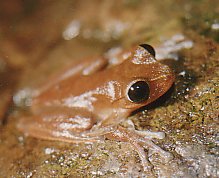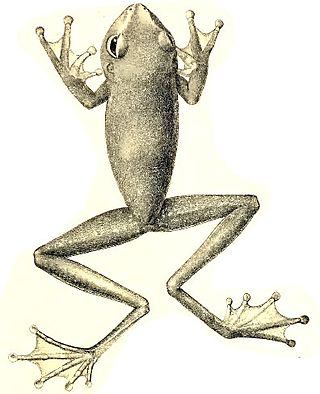
Nyctimystes is a genus of tree frogs in the subfamily Pelodryadinae of the family Hylidae. They are principally Papuan species, but also inhabit islands in the Moluccas. All species in this genus have one distinct feature that separates them from other species in the family, the lower eyelid is marked with pattern of lines, veins, or dots. This feature presumably acts as camouflage when the frogs are at rest during the day.

The white-lipped tree frog is a species of frog in the subfamily Pelodryadinae. It is the world's largest tree frog and is found in Australia. Other common names include the New Guinea treefrog, giant tree frog, and Australian giant treefrog.
Nyctimystes disruptus, also known the Madang big-eyed tree frog and Richard's big-eyed tree frog, is a species of frog in the subfamily Pelodryadinae, endemic to New Guinea. Its natural habitats are subtropical or tropical moist montane forests, rivers, rural gardens, and heavily degraded former forest.
Nyctimystes gularis, the Mondo big-eyed tree frog, is a species of frog in the subfamily Pelodryadinae, endemic to Papua New Guinea. Its natural habitats are subtropical or tropical moist montane forests and rivers.

Nyctimystes montanus is a species of frog in the subfamily Pelodryadinae. It is endemic to the Arfak Mountains, located in the Bird's Head Peninsula of northwestern New Guinea. This species is only known from its type locality. There are no records of this species after it was described in 1878, perhaps because of lack of surveys.
Nyctimystes narinosus, the common big-eyed treefrog, is a species of frog in the subfamily Pelodryadinae of the family Hylidae. It is endemic to New Guinea and occurs in the Wahgi-Sepik Dividing Range and the Schrader Mountains, on both sides of the border between Papua (Indonesia) and Papua New Guinea. There is, however, some uncertainty about the western limit of this species. Despite its vernacular name, Nyctimystes narinosus is not a common species.
The parachuting frog, or pale-eyed parachuting tree frog, is a species of frog found in New Guinea. It is in the Nyctimystes gramineus complex with the Pinocchio frog and montane Pinocchio frog.
Nyctimystes hunti is a species of tree frog in the subfamily Pelodryadinae. It is endemic to northern Papua New Guinea. Scientists have seen it only in Utai, Sanduan Province, but predict that also lives elsewhere on New Guinea.
Nyctimystes eucavatus is a species of tree frog in the family Hylidae. It is endemic to eastern Papua New Guinea. Scientists have observed it between 800 and 1200 meters above sea level in the eastern mountains.
Nyctimystes sauroni is a species of tree frog in the subfamily Pelodryadinae. It is endemic to Papua New Guinea. Scientists know it solely from the Kikori Integrate Conservation and Development Project area.
Nyctimystes traunae is a species of tree frog in the subfamily Pelodryadinae, endemic to Papua New Guinea. It lives on mountains in the centre of the island in the Western Highlands Province. Scientists have seen it about 800 meters above sea level.
Nyctimystes pallidofemora is a species of tree frog in the subfamily Pelodryadinae, endemic to Papua New Guinea. Scientists disagree about whether this frog is best placed in the genus Nyctimystes or the genus Litoria.
Nyctimystes ocreptus is a species of tree frog in the subfamily Pelodryadinae, endemic to Papua New Guinea. Scientists have observed it on Mount Albert Edward, 2600 meters above sea level. Some may also live on Mount Victoria or Mount Knutsford.
Nyctimystes cryptochrysos is a species of tree frog in the subfamily Pelodryadinae, endemic to Papua New Guinea. It lives on Fergusson Island between 900 and 1500 meters above sea level. Scientists suspect it may also live in the D'Entrecasteaux Islands.
Nyctimystes nullicedens is a species of tree frog in the subfamily Pelodryadinae. It is endemic to Papua New Guinea and has been found on the south-western side of Mount Obree, at 550 meters above sea level.
Nyctimystes calcaratus is a species of frog in the subfamily Pelodryadinae, endemic to New Guinea. Scientists observed it about 1230 meters above sea level near a forest stream.
Nyctimystes myolae is a species of tree frog in the subfamily Pelodryadinae, endemic to Papua New Guinea. Scientists observed this frog near the village of Myola village, at 2000 meters above sea level.
Nyctimystes latratus is a species of tree frog in the subfamily Pelodryadinae endemic to Papua New Guinea. Scientists have seen it between 500 and 1200 meters above sea level on Mount Dayman and near the Bai-u River.
Nyctimystes kuduki is a species of tree frog in the sub-family Pelodryadinae. It is endemic to Papua New Guinea and is found in montane rainforests in Southern Highlands Province.


